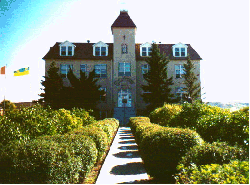![]()
|
|
|
|
|
|||||

Success Stories
 Canada’s
Digital Collections puts French Minorities in Western Canada on the Digital
Map
Canada’s
Digital Collections puts French Minorities in Western Canada on the Digital
Map
Francophone communities in Western Canada praise CDC
The small pockets of French-speaking minorities dispersed west of Ontario have two important challenges they must regularly confront resisting assimilation in an English-speaking environment and establishing a support network for all French minorities in Western Canada. The overwhelming presence of English-speaking media and English speaking services offered in Western Canada challenges the integrity of francophone culture and language. More importantly, francophone communities are geographically isolated from each other, making it difficult to establish a strong support network until the Internet.
Thanks to Canada’s Digital Collections (CDC), some francophone communities are able to widely distribute information on French-speaking services and publish their local history in digital format on the Internet at reasonable costs.
French-speaking communities west of Ontario have produced four digital collections which include: Manitoba en Filigranes, Faculté d’Éducation du Collège Universitaire de Saint-Boniface (CUSB): Hier, Aujourd’hui, Demain, Saskatchewan Francophone Collections and The Willow Bunch Museum and its Historical Figures. Others are currently in production.
Manitoba en Filigranes was created by a group of students in Saint-Boniface, a francophone community along the Red River adjacent to Winnipeg. Targeted at young Canadian students, the site has digitized a portion of the Société Historique de Saint-Boniface archives and highlights the life of Jean Baptiste Lagimodière (1778-1856) one of Canada’s greatest coureur de bois. An itinerary of activities allows students to learn more about their Francophone heritage and their local history. Manitoba en Filigranes also contains a section for teachers, explaining how this site can be easily integrated into a school curriculum.
Another collection from the St. Boniface francophone community is Faculté d’Éducation du CUSB: Hier, Aujourd’hui, Demain which retraces the history of the Department of Education of the Collège Universitaire de St. Boniface.
The CUSB Department of Education was founded 25 years ago during a rush of events that followed the report of the Laurendeau-Dunton Royal Commission which recommended ways of promoting official bilingualism in all regions of Canada and led to the Official Languages Act of 1969". The Department of Education aimed to supply the province with highly qualified teachers for the growing numbers of schools using French as the language of instruction. Information on the Department’s history, qualifications needed to be admitted, information on the program as well as teaching units for natural sciences teachers are included in the site. “Étudier en français au CUSB, c’est mettre toutes les chances de réussir de son côté. C’est se brancher pour réussir.”
Further west, Saskatchewan has added two collections on Canada’s Digital Collections’ Web site. They are: Patrimoine Fransaskois produced in Saskatoon by a team of 7 youths under the guidance of L'Association culturelle franco-canadienne de la Saskatchewan and The Willow Bunch Museum and its Historical Figures produced in the small French-speaking community of Willow Bunch.
The Patrimoine Fransaskois, done in collaboration with the Bureau de la Minorité de langues officielles en Saskatchewan, offers French-speaking intermediate and high school students in Saskatchewan research tools in the areas of history and the humanities. Seven subcollections present important historical accounts of the Fransaskois community. The Culture, Métis Pioneers and Fransaskois Pioneers and Women Pioneers sections provide information on historical figures such as Louis Riel and Marie-Anne Duperreault, one of the first women journalists in Saskatchewan who wrote for over 25 years for Patriote de l’Ouest. Addresses of various francophone organizations can also be found within the Communities and Associations sections.
Yvan LeBel, a teacher and team leader for the Patrimoine Fransaskois Web site, describes the students’ experience positively, “The CDC project was a great learning experience for the students. It introduced them to the many facets of today’s workplace. It was an opportunity to learn about their heritage and ancestry. It exposed them to the fundamentals of web technology, helped them build a strong team collaboration and finally allowed them to develop a good work ethic while earning wages.” Mr. LeBel also acknowledges the advantages for the community, “It allowed us to remember certain events and to rediscover our history from the early settlements in Western Canada to the present.”
The Willow Bunch Museum and its Historical Figures Web site was produced by 4 students in Willow Bunch at the Talles de Saules Community Center. Willow Bunch is a small francophone community founded in 1870 by fur trader, Jean-Louis Légaré who also helped facilitate Métis and federal government negotiations.
Since then, other individuals have also put Willow Bunch on the map. These include the Beaupré Giant who grew to be eight feet tall, the Campagne family whose musical talents include Carmen Campagne and Hart Rouge as well as Sitting Bull, a Sioux Indian chief who sought refuge from the US government in Willow Bunch in 1876 and finally, Charles Skinner, a Canadian test pilot pioneer.
The CDC project allowed the francophone students to work in a French-speaking environment, an unusual and important opportunity for the students. “Being a francophone minority in Saskatchewan, these opportunities are rare. It was an important work experience for the students because it permitted them to work in French which helps them preserve their culture and their first language,” explains Mr. Tremblay, project supervisor and director of the Talles de Saules Community Centre.
Visit the Canada's Digital Collections World Wide Web Site at http://collections.ic.gc.ca
|
Updated: |